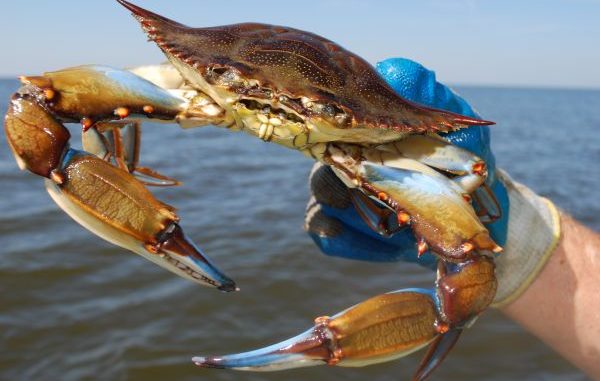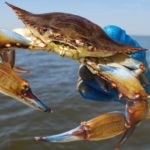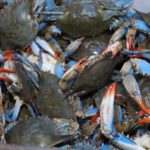
What do crabs eat?
Blue crabs are one of the most-beautiful and interesting creatures in Louisiana’s coastal marshes. They are pugnacious — actually downright aggressive may be a better characterization — but within those armored bodies lies some of the most delectable of all seafoods.
Here are some fun facts about our friend, the blue crab (Callinectes sapidus).
Blue crab food habits
If you ask most people what blue crabs eat, the common answer will probably be dead fish because that’s what most people use (besides chicken parts) to catch them.
However, research shows that crabs eat a wide variety of food items. The study below, done in Lake Pontchartrain, showed the following food items in blue crab diets by weight:
Food Item Percent of Diet
Mollusks (oysters, clams, mussels)46
Crustaceans (crabs, shrimp)24
Organic debris 22
(broken down plants and animals)
Plants 4
Fishes 2
Other 2
Research done in Florida’s Apalachicola Bay showed the breakdown below on crab food items by volume:
Food Item Percent of Diet
Bivalves (oysters clams, mussels) 36
Fishes 12
Crabs 11
Shrimp 5
Snails 5
Plants 4
Other 27
Finally, Alabama biologists showed the following results in a study on blue crab diets in Mobile Bay:
Food Item Percent of Diet
Fishes 50
Bivalves (clams, mussels, oysters)22
Crabs 16
Snails 5
Other 7
As can be seen, mollusks, which include bivalves and snails, rank very high as important food sources for blue crabs. Oystermen all maintain that blue crabs are deadly predators of small spat oysters.
Only the Alabama study showed fish ranking very high as a food item.
Crabs feed by grabbing food items with their claws and the first pair of walking legs. Hard items are crushed and broken with their claws before being swallowed.
Besides grasping food with their claws, blue crabs also feed by picking small items off the bottom or by scraping them off of firm surfaces with their mouth parts. Tiny floating foods are brought into their mouths by currents they create by rapidly moving their mouth parts.
Blue crabs locate food items by smell, touch and vision.
Size does matter
Blue crabs have an interesting reproductive cycle. Females have a single opportunity to mate in their lives, during the last molt of their shell. Typically, a female pairs up with a male, who cradles her under his body for several days before she molts and up to four days after the molt.
Mating takes place over a five- to 12-hour period, during which the male passes packets of sperm called spermatophores into the female.
The female can store the sperm from this one mating in her body for up to 12 months, and from it can produce eight to 11 broods of eggs. Each brood has 2 million to 6 million eggs.
In the wild, large males are more often paired up with females than are smaller males, and larger males are usually paired with larger females that will produce more eggs.
Not only body size counts, but large claws do too. Males missing one or both claws, or that have small claws, cannot compete with males with two large claws.
Large males tend to guard females longer than smaller males to prevent them from mating with other males. Large males also produce and transfer to females more sperm and spermatophores.
If a male mates with a second female shortly after mating with the first one, his supply of sperm is reduced, producing an advantage for larger males that started with more sperm before mating. It takes approximately nine days for a male to rebuild his sperm supplies after mating.
Another factor influencing the amount of sperm a male passes to a female in mating is the presence of other males. If many other males are present in the environment, a male will transfer more sperm to his mate and guard her longer than if few males are present.
There is some evidence that the number of fertilized eggs a female can produce can be limited by the amount of sperm she gets during her last molt. Also, sperm seems to lose its viability the longer the female stores it.
Fisheries biologists tend to think in terms of managing a resource to protect enough females to produce eggs for the next generation. Having enough males present is taken for granted, because in most fisheries species males produce so much sperm and because they broadcast it out into the water where it can fertilize the eggs of more than one female.
Blue crabs might be different. Wherever they are fished, large males tend to be targeted as the most highly prized catch. Removing large numbers of large males reduces females’ access to males with large sperm supplies; the lack of competition between males also results in males protecting females for shorter times after mating.
Fewer large males means that small males, which started with smaller sperm supplies, will mate more frequently than they can rebuild their sperm supplies, resulting in even less sperm being transferred per mating.




